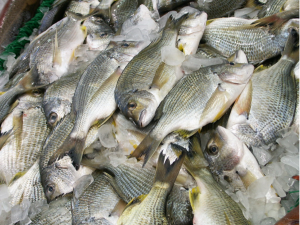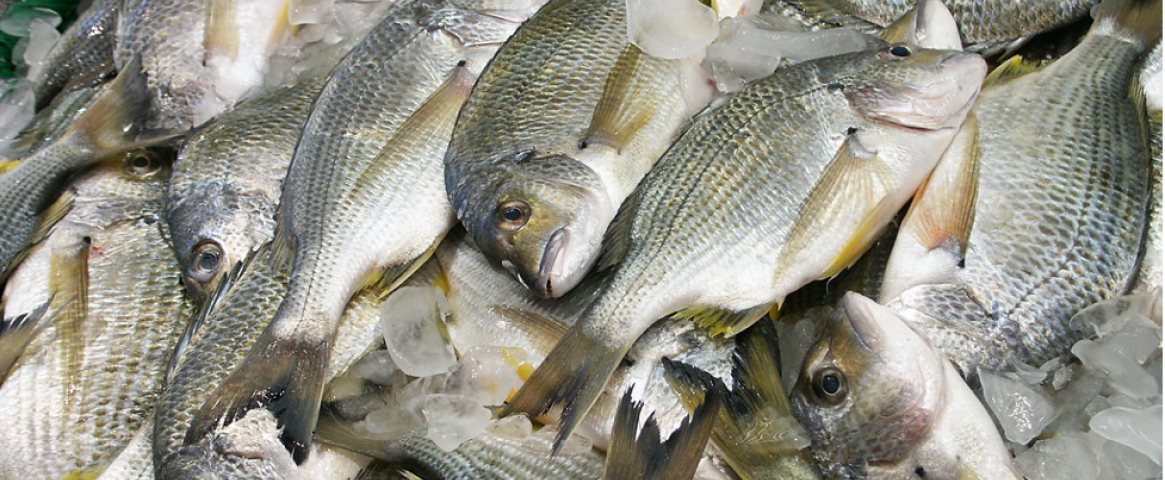By Annabelle Moore

Americans waste as much as 47% of the purchase, according to 2015 research by the Johns Hopkins Center for a Livable Future. This waste is a missed opportunity for human nutrition and is environmentally expensive, according to Roni Neff, an associate professor with the Bloomberg School of Public Health at Johns Hopkins University, who participated in the 2015 study. Neff’s team surveyed 2,113 people nationally to explore consumer knowledge and habits around safe seafood consumption. They found consumers weren’t confident about their ability to identify high-quality seafood at fresh markets or home while dethawing fish.
The study was presented at the AAAS meeting this February in a session focused on the amount of seafood waste, what drives it, and strategies to prevent it.
Survey participants showed confusion about how long it’s safe to keep frozen and canned seafood—86% of survey participants said they throw out seafood as soon as it smells “fishy.” But USDA food safety guidelines allow for safe consumption of cooked fresh fish within four days after purchase if refrigerated and two months if frozen. Shellfish should be eaten within four days or frozen up to three months, as long as the fish is cooked to the right temperature, regardless of odor.
Consumers were motivated to reduce seafood waste to save money, increase home efficiency, and set positive examples for children, but only about 35% considered waste as having an environmental component. “There’s very little public knowledge about the environmental impacts of seafood, and that’s true in the whole food waste domain,” says Neff. “There’s an important win-win if consumers can benefit by saving money and that benefits the environment. We can focus on both.”
Seafood production—whether wild-caught or from aquaculture—requires less energy, water, and feed than growing land animals like chickens, pigs, and cows for food. So both for sustainability and health, the US Departments of Health and Human Services and Agriculture have recommended that Americans consume seafood two to three times a week.
But only 10-20% of Americans meet this goal. “Seafood is one of the least consumed protein sources in the United States,” says Neff. “That’s notable because of its many important health and environmental benefits.” The 2015 study by Neff and colleagues determined fish markets, restaurants, and consumers contribute to over half of all seafood waste in the U.S. supply chain.
Seafood was defined as consumable fish, crustaceans, and shellfish. At the time, the team calculated if the waste was transformed into edible nutrients it would amount to enough protein for an estimated 10 million adults—all without changing current seafood production rates.
The purchase of frozen foods has increased in the last year as more people are cooking from home because of the pandemic. One strategy to address seafood waste and consumer confusion is to share recipes that people can use to cook seafood directly from frozen.
Neff notes that if fish is never defrosted, it never has the opportunity to decay in stores or at home, and points to examples such as the effort by students at the Drexel University Food Lab and the World Wildlife Fund to create consumer-friendly recipes and a public brochure for shrimp, tilapia, and salmon.
The seafood often sold in “fresh” counters at the grocery store is pre-frozen and then thawed. This introduces additional water waste in thawing fish, notes the Drexel team. It truly isn’t as fresh as it would be if kept frozen all along the chain from harvest to consumer.
“The survey reveals multiple opportunities to reduce seafood discards,” says Neff. “I think it can help us to move forward as we think about how consumer anxieties, how our lifestyles, our skills, and our preferences all play out in terms of the food and seafood we discard.”
Annabelle Moore is a graduate student in the Johns Hopkins University Master of Arts Science Writing program. She has written for Undark, STEM, and humanitarian non-profit blogs. She can be reached at ab.moore@protonmail.com.
This story was edited by NASW member Maureen Langlois, who served as Moore's mentor during the NASW-AAAS Spring Virtual Mentoring Program.
Sources:
-
“Advice about eating fish.” FDA. 12/29/2020. https://www.fda.gov/food/consumers/advice-about-eating-fish.
-
Center for a Livable Future. Accessed February 2, 2021. https://clf.jhsph.edu/
-
“Cooked Fish All.” USDA FoodKeeper App. FoodSafety.gov April 26, 2019. https://www.foodsafety.gov/keep-food-safe/foodkeeper-app
-
“Cooked Shellfish All.” USDA FoodKeeper App. FoodSafety.gov April 26, 2019. https://www.foodsafety.gov/keep-food-safe/foodkeeper-app
-
Drexel Food Lab. https://drexel.edu/cnhp/research/centers/foodbionutritioncore/Drexel-Food-Lab/
-
“FoodKeeper App.” FoodSafety.gov accessed on February 21, 2021. https://www.foodsafety.gov/keep-food-safe/foodkeeper-app
-
Love, D., et. al. "Food Sources and Expenditures for Seafood in the United States." Nutrients 12, no. 6 (2020): 1810. doi: http://dx.doi.org.proxy1.library.jhu.edu/10.3390/nu12061810
-
Love, D., et. al. “Wasted Seafood in the United States: Quantifying loss from production to consumption and moving toward solutions.” Global Environmental Change, 35 (2015), 116-124 https://doi.org/10.1016/j.gloenvcha.2015.08.013
-
Deutsch, J. et al. “Eliminating Waste from the Seafood Supply Chain: The benefits and challenges of ‘frozen’.” Drexel University Media. No date. https://drexel.edu/cnhp/research/centers/foodbionutritioncore/Drexel-Food-Lab/
-
“Reducing Waste in the U.S. Seafood Supply Chain.” Speakers: Jillian Fry, Lekelia Jenkins, Roni Neff. Moderator: Dave Love. February 9, 2021. The American Association for the Advancement of Science Annual Meeting Scientific Session. https://virtual.aaas.org/reducing-waste-in-the-u-s-seafood-supply-chain
-
Roni Neff, associate professor, Bloomberg School of Public Health, Johns Hopkins University, Baltimore, Maryland. https://www.jhsph.edu/faculty/directory/profile/1991/roni-a-neff
-
“Seafood Health Facts: Making Smart Choices.” Delaware Sea Grant. 2020. https://www.seafoodhealthfacts.org/seafood-nutrition/patients-and-consumers/seafood-and-current-dietary-recommendations
-
“Wasting Seafood: Insights from U.S. Consumers.” Roni Neff, Bloomberg School of Public Health, Johns Hopkins University. February 2021. The American Association for the Advancement of Science Annual Meeting, Scientific Session: spotlight video. https://virtual.aaas.org/wasting-seafood-insights-from-us-consumers.


